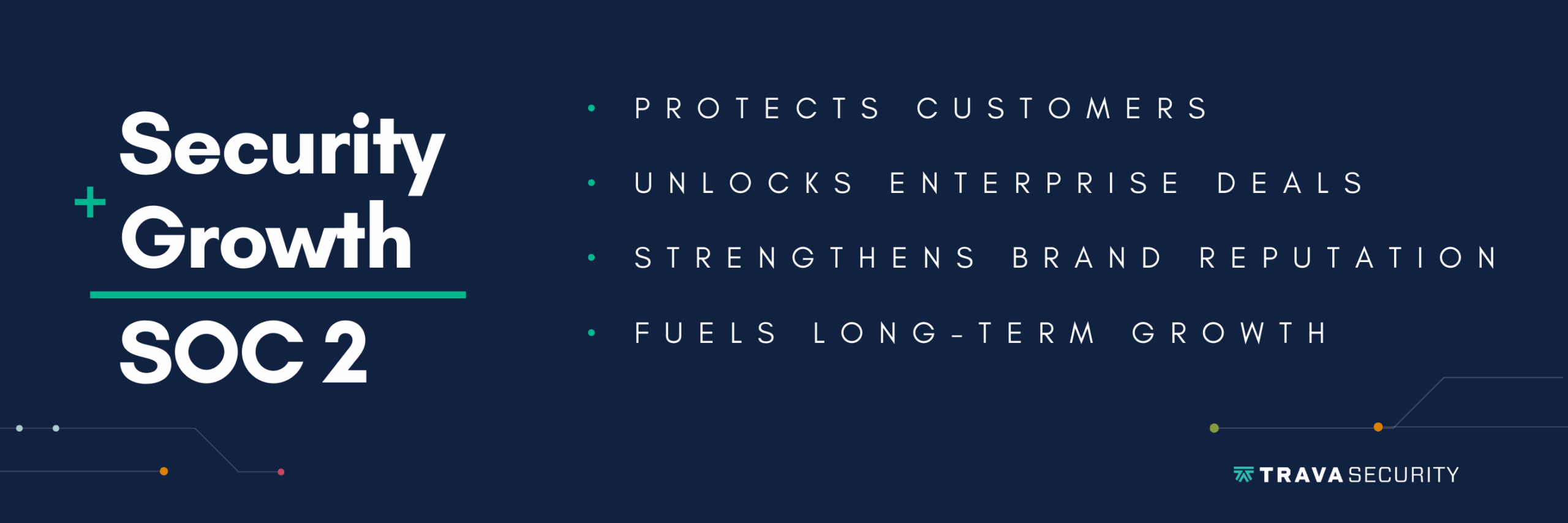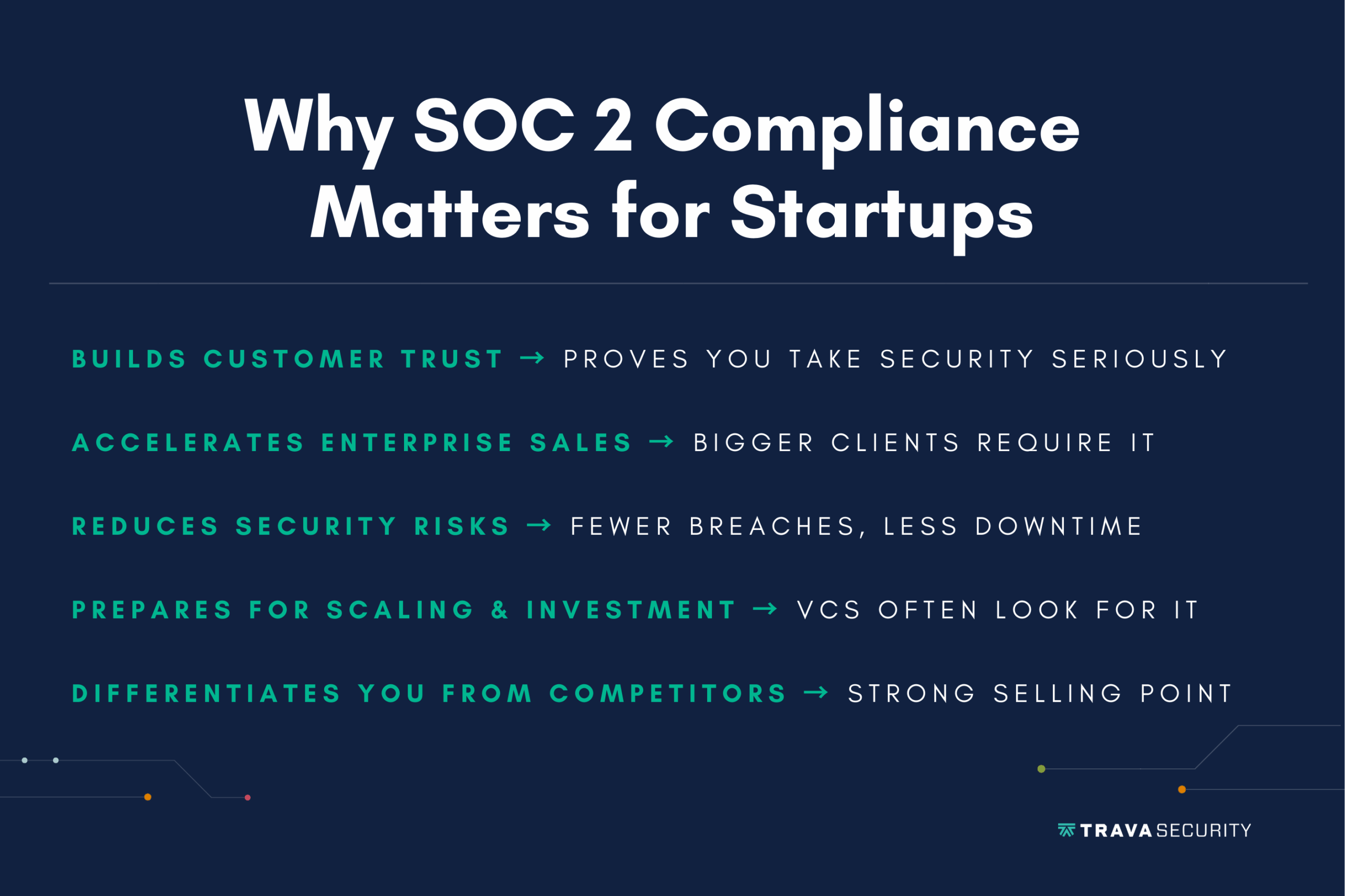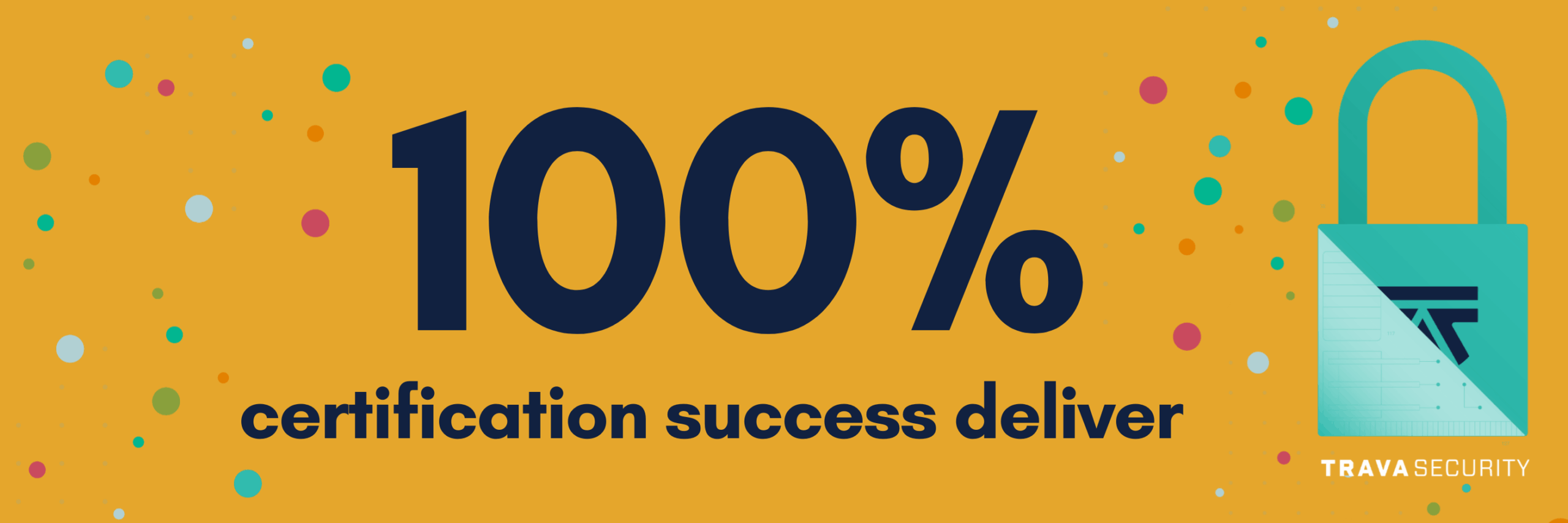Last Updated: November 24, 2025
Table of Contents
- Why do engineering teams resist SOC 2 compliance?
- How can you implement SOC 2 controls without overloading your engineering team?
- What measurable business benefits can startups see from SOC 2 compliance?
- How does Trava support startups in SOC 2 compliance?
- Balance security and innovation with experts
- FAQ: SOC 2 Compliance for Startups
SOC 2 compliance is essential for maintaining your cybersecurity and building customer trust, but it often feels like a roadblock to fast-paced development. Many engineering teams resist compliance efforts due to added workload and perceived inefficiencies, but some care and the right assets can boost your compliance without lengthening your SDLC.
In this article on SOC 2 compliance for startups, we’ll show you how you can achieve SOC 2 certification without disrupting your engineering workflows, including practical steps you can take to streamline your compliance efforts while maintaining efficiency.
Why do engineering teams resist SOC 2 compliance?
Whether it’s inertia, red tape, or confusion, teams can resist compliance initiatives for all sorts of reasons. Understanding them can help you clear your compliance hurdles, so taking an inventory of your current SOC 2 posture is the first step in improving your compliance. Some factors that often hold up SOC 2 compliance for startups are:
- Bureaucracy. Some teams find compliance tasks bureaucratic. If compliance slows down product development or security and documentation requirements seem excessive, teams will be less likely to follow through.
- Confusion. Lack of clear ownership often results in last-minute compliance scrambles. Without clear leadership, roles, and direction, compliance tasks often slip through the cracks.
- Preference. Engineers prefer focusing on building features, not security checklists. The extra compliance focus turns development teams away from building a better product, unless you have a clear compliance framework in place.
When your team sees SOC 2 compliance as a hindrance to product development, they won’t make compliance a priority. Communication breakdowns also hinder collaboration between departments, causing important compliance information to go overlooked. But with clear leadership and the right SOC 2 tools in place, you can eliminate the oversights that occur due to siloed workflows and streamline your compliance processes — without sacrificing productivity.
How can you implement SOC 2 controls without overloading your engineering team?
Implementing SOC 2 doesn’t have to overwhelm your engineers with extra work. Simplify compliance by sharing responsibilities beyond the engineering team, integrating SOC 2 security standards into your existing workflows, and getting external compliance support when necessary. Here’s a detailed breakdown of SOC 2 best practices for developers:
1. Assign Compliance Ownership Outside Engineering
The first step toward elevating SOC 2 compliance for startups is to appoint a leader to handle the job — and they shouldn’t just come from engineering.
Compliance is a team effort, requiring collaboration from multiple departments. Having all hands on deck can bring greater clarity to any compliance issues that may be overlooked. To streamline your compliance workflows, start by designating a compliance manager or security team to handle documentation and audits. Then, foster a cross-functional environment by involving legal, IT, and DevOps teams to distribute all the responsibilities. Also, clearly define all compliance roles so that your engineers won’t be burdened with administrative duties.
2. Schedule Compliance Work in Low-Impact Phases
Your team is bound to let compliance fall by the wayside if it takes up too much of your product development, so it’s better to integrate it into your sprints. Start by aligning your security and compliance efforts with product roadmaps, ensuring that development stays on schedule. Then, perform security reviews and policy updates during lower-priority sprints, where more time is available for compliance. Also, batch your compliance-related tasks together to minimize interruptions so that your team will face fewer delays.
3. Use Tools and Services That Make SOC 2 Easier
Once you have a framework in place that simplifies SOC 2 for engineering teams, the next step is to give them tools that streamline their compliance tasks. SOC 2 automation platforms can offload the burden of tedious compliance workflows from your team and ensure that no task is overlooked. A few leading compliance automation platforms are:
- Secureframe, for monitoring security, automating risk mitigation, and achieving industry-leading security standards (SOC 2, HIPAA, GDPR, CCPA, ISO 27001, PCI DSS)
- Drata, for evidence collection and risk management automation
By using SOC 2 tools that can simplify burdensome compliance duties, your team will not only be better equipped to maintain their compliance, but they’ll also be able to do it without compromising efficiency.
4. Work With a Trusted Partner
The right tools are essential, but the best tool is often an experienced partner that can help you along your compliance journey. If you find yourself especially burdened by or unsure of your compliance requirements, consider leveraging the expertise of seasoned external SOC 2 consultants to guide you through the process.
A few services that a consultant could offer your DevOps and SOC 2 compliance teams are:
- Virtual CISOs (vCISOs) that provide expert leadership and risk management without the cost of a full-time executive
- Compliance as a Service (CaaS), which gives you access to experts who can help your business achieve complete compliance, from planning to design to management
- Cybersecurity risk assessments, which elevate cybersecurity throughout your organization with customized insights and actionable intelligence
- Penetration testing, which uncovers vulnerabilities before hackers can, bolstering your cybersecurity and compliance
- Internal audits, including a comprehensive audit of your company’s controls
Some companies may be concerned that working with a consultant is too cost-prohibitive for their operations, especially if they’re SMBs. But the gains provided by the added efficiency and improved compliance more than offset the investment — and the cost is often less than a fine. Check out our webinar on finding the right cybersecurity partner for more info.

What measurable business benefits can startups see from SOC 2 compliance?
SOC 2 is one of the most trusted cybersecurity frameworks out there. Meeting its requirements shows customers and regulators that your security practices effectively protect sensitive data. Some of the biggest benefits of SOC 2 compliance for startups include:
Fewer Security Incidents
SOC 2 compliance for startups helps you avoid the serious consequences of a cyber attack — expensive legal fees, costly downtime, high data recovery costs, and damaged reputation.
Instead of waiting for an incident to happen, you reduce the risk of data breaches by implementing robust security measures.
Increased Customer Trust
Research shows that 66% of customers in the United States wouldn’t trust a business with their data after a breach. Seventy-five percent would stop buying from a brand if it becomes a victim of a cyber incident.
With SOC 2’s strong cybersecurity standards, you prevent cyber breaches from occurring. You show customers that you handle their sensitive data securely, which can maintain or even boost their confidence in your startup.
Competitive Differentiation
Enterprise customers, especially those in highly regulated industries such as healthcare and finance, prefer to work with SaaS companies that have solid cybersecurity measures. Implementing SOC 2 security requirements can differentiate your startup from non-compliant competitors.
Faster Sales Cycles
Some clients specifically require SOC 2 compliance before buying a SaaS subscription. With an SOC 2 report from an independent auditor, you can provide such potential customers with immediate assurance that your security measures meet their standards. This can accelerate the process of converting them into paying customers.
Boosted Investor Confidence
According to PwC’s 2024 global survey, cybersecurity is the number one concern for investors. SOC 2 compliance for startups not only demonstrates reliable security controls but also shows operational maturity, which may attract investors and partners.
Improved Operational Efficiency
SOC 2 audits often reveal redundant or inefficient security procedures. With these insights, it’s easy to make your cybersecurity operations more efficient.

How does Trava support startups in SOC 2 compliance?
Trava offers compliance as a service solutions that cover everything you need to get ready for a SOC 2 audit and certification. Trava has a 100% success rate in helping clients achieve SOC 2 compliance.
If you partner with Trava, you’ll get:
- Cybersecurity advice that makes you audit-ready up to 75% faster than preparing for the audit on your own
- Compliance guidance for SOC 2 and other relevant security frameworks and regulations, including ISO 27001, HIPAA, CMMC, GDPR, and CCPA
- Scalable compliance programs that grow with your business
- Penetration testing services to identify and fix weaknesses in your system before they cause a cybersecurity incident
We recognize the complexities of SOC 2 compliance for startups, and we work alongside clients of all sizes to give them the guidance and tools they need.

Balance security and innovation with experts
Some companies compromise on compliance because they find it a hindrance to their development efforts, but it doesn’t have to be. Approach it strategically, and your SOC 2 compliance can strengthen your cybersecurity posture and your broader business growth as a whole. Automation, clear ownership, and smart scheduling can help reduce friction, and working with an experienced compliance partner can help you navigate uncharted waters.
Do you need a trusted partner to help you navigate your regulatory requirements? Talk to Trava today.
FAQ: SOC 2 Compliance for Startups
How do I keep SOC 2 from slowing down product releases?
Integrate compliance tasks into existing sprints, batch administrative work, and assign ownership outside engineering. Strategic scheduling and automation ensure compliance doesn’t disrupt your development cadence.
Do startups need a full-time security team for SOC 2?
Not necessarily. Many startups leverage cross-functional teams with support from virtual CISOs or Compliance-as-a-Service (CaaS) providers. This approach provides expert oversight without the cost of hiring a full-time security team.
How long does it take to become SOC 2 audit-ready?
Timelines vary based on your startup’s size, maturity, and current security posture. With proper planning and the right tools, some startups achieve readiness in as little as 3–6 months.
What are the most common SOC 2 pitfalls for startups?
Typical mistakes include unclear role ownership, overloading engineers with administrative tasks, and neglecting continuous monitoring. Addressing these early with a structured compliance framework prevents delays and audit issues.
Is SOC 2 required for all SaaS startups?
No, but it’s increasingly expected by enterprise clients and regulated industries like healthcare and finance. Even if not mandatory, SOC 2 can be a strong competitive differentiator.
Can SOC 2 compliance improve investor confidence?
Yes. Demonstrating strong security controls and operational maturity reassures investors that your startup is low-risk and professionally managed, which can be a deciding factor during fundraising.
How do I choose between SOC 2 tools and consultants?
Tools automate repetitive tasks and monitor compliance continuously, while consultants provide expertise, audit guidance, and risk assessments. Many startups benefit from combining both for maximum efficiency.
What should a startup prioritize first when starting SOC 2 compliance?
Begin with a clear assessment of your current security posture, assign compliance ownership outside engineering, and identify gaps in policies and controls. Early planning reduces surprises during the audit process.
How can startups scale SOC 2 compliance as they grow?
By embedding compliance into workflows, leveraging automation, and partnering with experts, startups can expand their SOC 2 program alongside business growth without slowing down engineering or operations.


